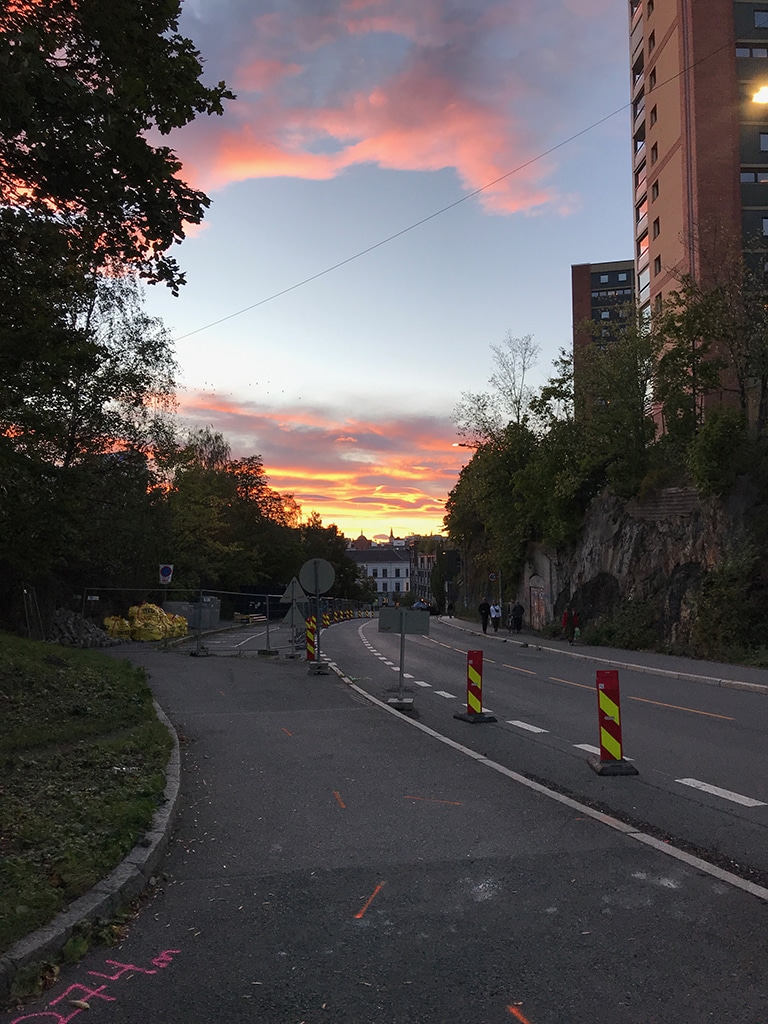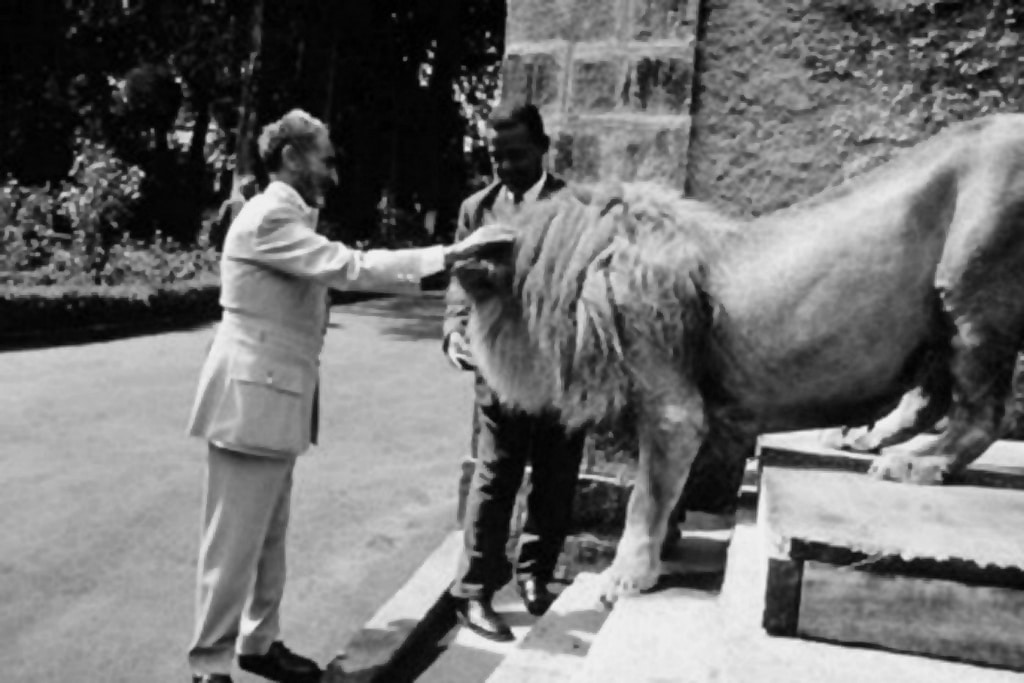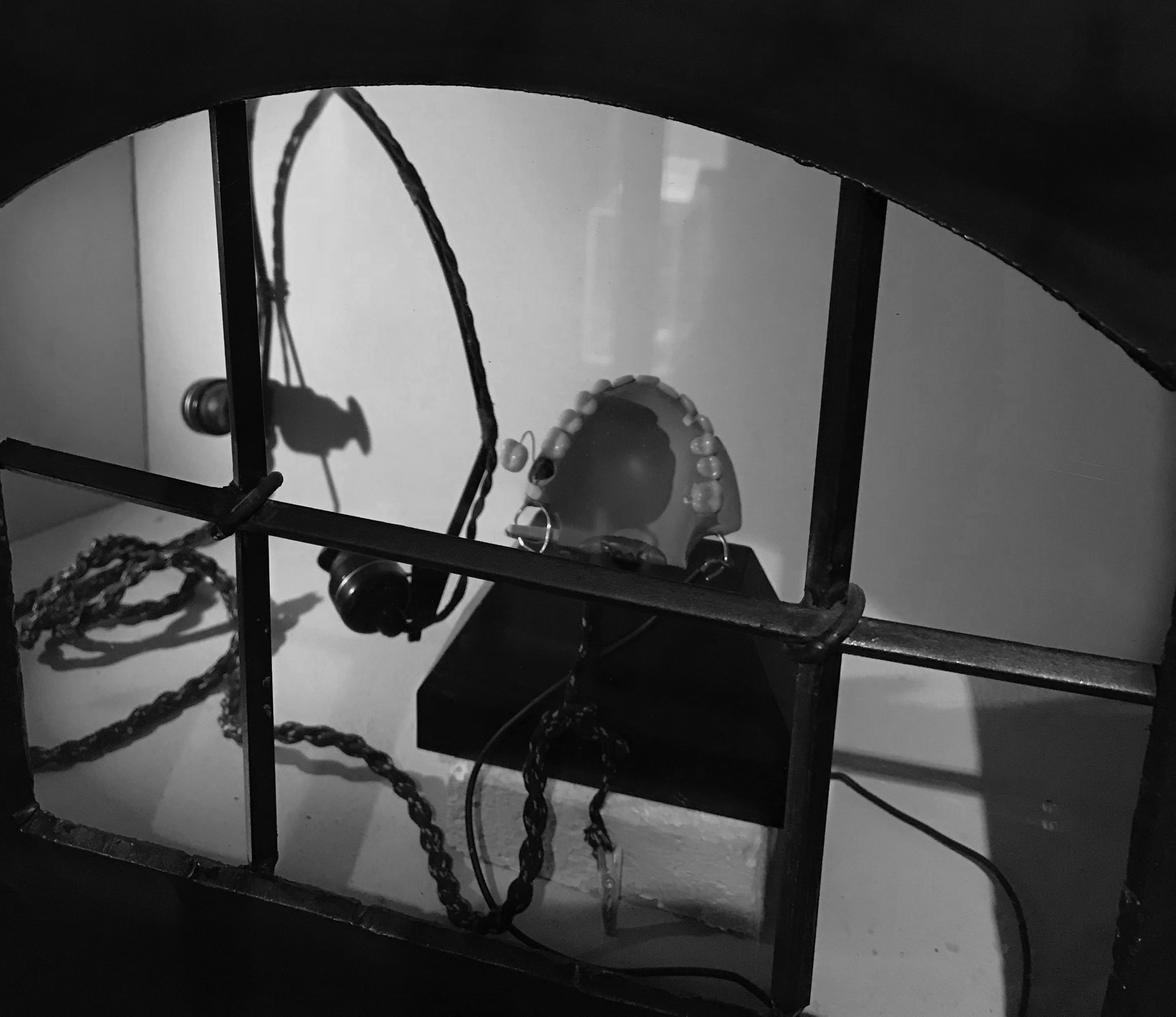Read part 1 here
The museum was at the end of a cobblestoned corridor. The shred of sky above it leaked pale orange twilight. As Dale walked down the corridor the walls gradually narrowed, so that at the end of it, he needed to swish his shoulders a little in order to squeeze through.
The building that housed the museum was one story tall like all the rest, except it was painted royal green, with a pitched white roof. The door was impenetrable oak and the door’s peephole sat in the middle of a small, eye-shaped brass fixture. Dale rang the buzzer with his left hand. A couple minutes passed and Dale rang the buzzer again.
This prompted a voice over intercom to say some unintelligible thing, then a buzzing-in rattle. Dale pushed the door, surprised to find it light as a feather.
He entered a vestibule so dark he needed to let his eyes adjust. A tiny light illuminated a two-tiered fountain, its gurgle barely perceptible. As Dale stood there, the light and gurgle seemed to grow brighter and louder as his senses acclimated. Then Dale saw that the walls were covered by floor-to-ceiling frescoes: scenes of women in the throes of birth, masses of bodies swirling around in biblical frenzy, angels hovering above, wings incandescent.
Though he was no fountain aficionado, Dale could tell this was a cheap one, the kind he’d see in Florida front yards. Looking back at the door through which he’d come in, he saw two skeletons painted above it, embraced missionary-style, chinbone-to-chinbone.
Looking to his right, he noticed another doorway, which he was able to sense only from the rectangular aura of light coming from the other side. Dale stepped in front of it and knocked twice, and the door cracked open. Waiting a couple seconds, Dale pushed it, peeked his head into the next room. It looked like a dumpy waiting room for a doctor’s office: grey carpet, grey walls, fluorescent overheads, one of them flickering on and off.
Against a wall sat a large desk strewn with books and papers and miscellany, and behind the desk was a man with blonde hair up in a ponytail, wearing a purple cardigan that reminded Dale of his grandmother. The man had a cherubic face but the air of a wounded animal.
“Entrance to your right. Admission is free today.” His voice had the sound of running a finger along the rim of a cheap wine glass. He said it without looking up from the half-decayed manuscript on the desk in front of him.

Dale, never the sort of person who sought out the obscure or weirder corners of existence, considered leaving right then. He stood there contemplating his next move, and the man, who Dale assumed to be the caretaker of this place, looked up. “Please,” he said, clearly irritated. “I have to get back to work.”
Dale said nothing and just stood there for another 10 seconds as the caretaker went back to the manuscript, scribbling notes on a piece of paper.
The next room was dimly lit. It had zigzagging, homemade exhibition walls, built so you had to turn their corners to advance. On them hung impressionist paintings, some patterns black and fanning, others blue-green and splotchy. When Dale got closer to one of the paintings, he saw that there was some kind of image beneath the blue-green splotches.
The extent of Dale’s art knowledge was a poster of The Scream that hung in his childhood living room, so he read the wall text. He had to squint in order to read:
“The works contained in this room come from Stavanger Kunstforening, the precursor of today’s Kunsthall Stavanger. The Kunstforening was Norway’s first art association with their own building, built in 1914. The wooden shack was simply constructed, and very damp. The paintings you see before you were housed in that building, and grew various forms of fungus and mold. Preparators periodically treat these paintings so that the fungus and mold may remain, but not overtake, the paintings they’ve colonized. At the end of this room are the remains of a mailbox that also belonged to the Kunstforening. On the 850th anniversary of Stavanger, someone upset with the ban on fireworks stuffed the mailbox with explosives.”
As Dale walked on he apprehended the paintings from further away than before. The last painting was pretty much only mold, held in place by gilded frame. Then, there was the mailbox on top of a plinth, or rather, a pile of scorched wood that used to be a mailbox.
As Dale regarded the exploded mailbox, the caretaker suddenly appeared out of a small side-door, built so as to be practically invisible unless opened. He was mumbling to himself, paid no mind to Dale, and quickly walked through another previously invisible side-door.
Next was a small room with a single folding chair against the wall, a sickly spotlight aimed at a pair of headphones hanging from a nail.
The sounds were a collection of people uttering a single sound. To Dale, it sounded like the o in “hope.” He could tell it was a sound that Norwegians made but which didn’t exist in the English alphabet. Vocalizing this sound back-to-back was a throng of different voices, from bass to baritone to soprano, child to adult to elderly. Entranced, Dale sat there listening until his brain was semantically saturated. Even though the vowel sound had no meaning for Dale in the first place, it seemed to lose even more meaning than that.
Finally, a voice came on that was obviously the caretaker’s. After the Norwegian, the voice continued with an English translation: “Thank you for listening to this exhibit of historical and contemporary instances of the Norwegian vowel å. The å is a curious phonemic species, in that Norwegians use it to fill the space of their conversation. They will often utter the å as they are considering what to say next. Jenny Hval put it beautifully when she wrote: ‘You could say it’s Norwegian anxiety, expressed in a song we refuse to call a song, or a ritual, or anything but silence, but really it’s the sound of the beyond, a letter outside most other alphabets, an unconscious drone to confirm that we are still alive.’”
Dale placed the headphones back on the nail. He suddenly remembered the reason he came to this strange place in the first place. The panic had subsided. Or, he’d simply forgotten about it. Was there a difference?
Glee surged up from Dale’s belly. A confident, youthful bounce entered his gait as he went to the next room, which contained two sides of plastic vitrines. One contained a collection of objects smuggled to Norwegian prisoners who resisted Nazi occupation: table legs hollowed out for ear buds and dentures wired to receive the BBC’s European service broadcasts. Dale imagined these prisoners in the dead of night, hooking up to a pair of teeth in their cells, listening to messages from the exiled King Haakon VII, counter-propaganda, coded instructions.
The other vitrine held various leather vests and jackets, all of them studded, patched, and pentagrammed, items that formerly belonged to Norway’s anti-fascist black metallers. Among the indiscernible typefaces and arcane icons, Dale saw swastikas behind prohibition symbols, a decapitated Hitler head raining blood from its eyes.
A text from Dawn vibrated in his pocket: “Miss you honey. Talk soon?” Dale’s heart swelled. He so loved his wife, her reservoir of patience.
Eager to call her, he breezed through the following room, which contained countless snow globes: troll-looking characters standing atop Viking ships holding little Norwegian flags, quaint cottages with Norwegian flags and cartoony reindeers. All the globes were in various states of evaporation.
Another area of the room was dedicated to unrealized artist proposals. Dale only took the time to look at one, titled ideal conditions for the advancement of the art. Next to the title was a little post-it with a scrawled note: “Alternate title: de la Cruisey?” From skimming the document Dale saw that the proposal was addressed to an art collection in Miami. The artist wanted to install a jacuzzi in the backroom for its overworked employees so they could relax and discuss readings of people like Giorgio Agamben and Ole Bjerg. The only person Dale recognized in the reading list was Sigmund Freud.
The next room was unlike the others. Rather than the dark, drab, homebuilt aesthetic, this room was old-world burgundy with plush walls. It was well lit and twinkly, a chandelier hanging over a large, low platform that took up almost the entire room and left little space for visitors to walk. In the middle of the platform lay a large, taxidermic lion, its body flat like a rug, jaw open in a friendly snarl.
There was no wall text, nothing to indicate anything. Dale jumped a little when the caretaker appeared out of nowhere, saying, “Ah, so you’ve made it to the lion.” Before Dale could respond, the caretaker went on:
“In the 1990s J— was a young art student studying in Holland. One summer he was supposed to earn a living painting murals for a coffee shop, but it all turned out wrong and he ended up broke. So he decided to hitchhike to Sweden to his mother’s house to survive the summer. In Denmark he was picked up by a gang of Rastafarians from Uganda, who turned out to be members of the Scandinavian branch of the Black Panther party on their way to a meeting in Helsingborg. At the house they smoked gigantic joints and riffed on ideas regarding the Scandi revolution. He got bored by these men and went to join the women in the kitchen, who were cooking great big pots of food. One of them told J— something that gripped his imagination. Haile Selassie I, Emperor of Ethiopia, had a pride of lions, which symbolized the Lion of Judah. Apparently, one of these lions existed somewhere in Sweden. J— searched for years for the lion, but was never able to find a trace.

“In the years after that, J— had developed a collection of art and oddities. In 2011, he had a temporary pop-up of his museum located in an 18th-century hunting pavilion in Malmö. The occasional visitor would stop by and peruse the various items. One day a middle-aged couple came in. They were looking at a few of images of lions that J— had in his collection, including the Lion of Gripsholm Castle, a fine, fine specimen of taxidermic lion. J— struck up a conversation with the couple. They mentioned that their neighbor had a taxidermic lion, a lion that used to belong to none other than Haile Selassie I. Six months later, the middle-aged couple escorted J— to visit their neighbor, who turned out to be the son of Haile Selassie’s personal veterinarian, a man by the name of Sven Pohlmark.
“Sven and his wife—forgive me, but I cannot remember her name for the life of me—were living in Sweden in the 1950s and looking to move abroad. They’d considered Canada, but also heard that Addis Ababa was a bustling city. So Sven and his wife took their three children to the capital of Ethiopia. The couple cut themselves a little corner in the market by opening a taxidermy service for big-game hunters. Looking to make a little extra scratch, Sven realized that pet fish were unheard of in Ethiopia at the time. So he started importing aquarium fish from Sweden. He placed the fish in plastic bags filled with water, carried them in suitcases on the plane back.
“Sometime around this time, a delegation of Chinese diplomats paid a visit to Selassie. As a gift, they brought the emperor a school of Chinese goldfish—the ones with bulbous eyes. When the delegates left, the court was distressed because they had no idea what the hell to do with all these fish. An administrator mentioned that they knew a Swedish fish-man. Thus, Sven was summoned to the royal court. He of course does a very good job as the appointed caretaker of the royal fish, and in time, he is given more responsibility over the other animals of the court, including Selassie’s five Ethiopian lions. The emperor is so pleased with Sven that he offers one of his lions as a gift of gratitude. When the lion shuffled off its mortal coil, Sven turned it into a rug.
“Everything goes well for Sven until 1974, when the Derg stages a coup, topples the monarchy, and implements their Marxist-Leninist reforms. As the bullets flew, Selassie booked it to France, and Sven and his wife decide it is high time to leave Addis Ababa. So they pack their children and belongings onto a boat bound for Europe. The Derg executed most of Selassie’s lions, though today you can apparently see their descendants at the Addis Ababa Zoo.
“After Sven passed away, his son was left with the lion rug, uncertain of what to do with it. When J— showed up looking for this lion that he’d first heard about 20 years prior from the Rasta women, Sven’s son offered it up. J—, who is not so sure that he should be the one to own such a historical and religious artifact, has reached out to some museums about this possession. In the meantime, it his housed here, in the museum you currently stand in.”
Dale, who had too many questions, could only think to ask, “Hold on a second. Back up. What exactly is the name of this place?”
The caretaker, brow furrowed, spat his response: “I don’t have time for this. I simply must get back to work!” Turning around, he stormed past the platform with the lion and slipped through a door. After it closed, Dale’s phone started vibrating. Dawn was calling. But instead of answering it, he just stood there, blinking in the burgundy room.
Rob Goyanes is a writer, editor, and musician from Miami, Florida, living in Ridgewood, Queens. His writing has appeared in e-flux journal, Los Angeles Review of Books, and many other places. On his catalogue essay about Tomm El-Saieh for the 2018 New Museum Triennial, The New Yorker art critic Peter Schjeldahl wrote, “That sounds right.”


